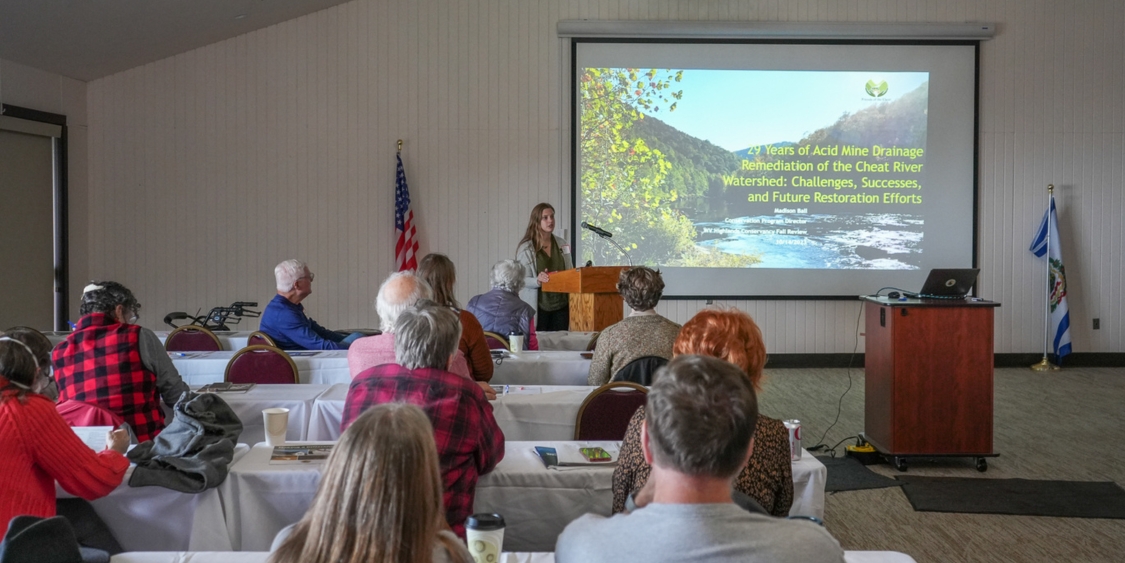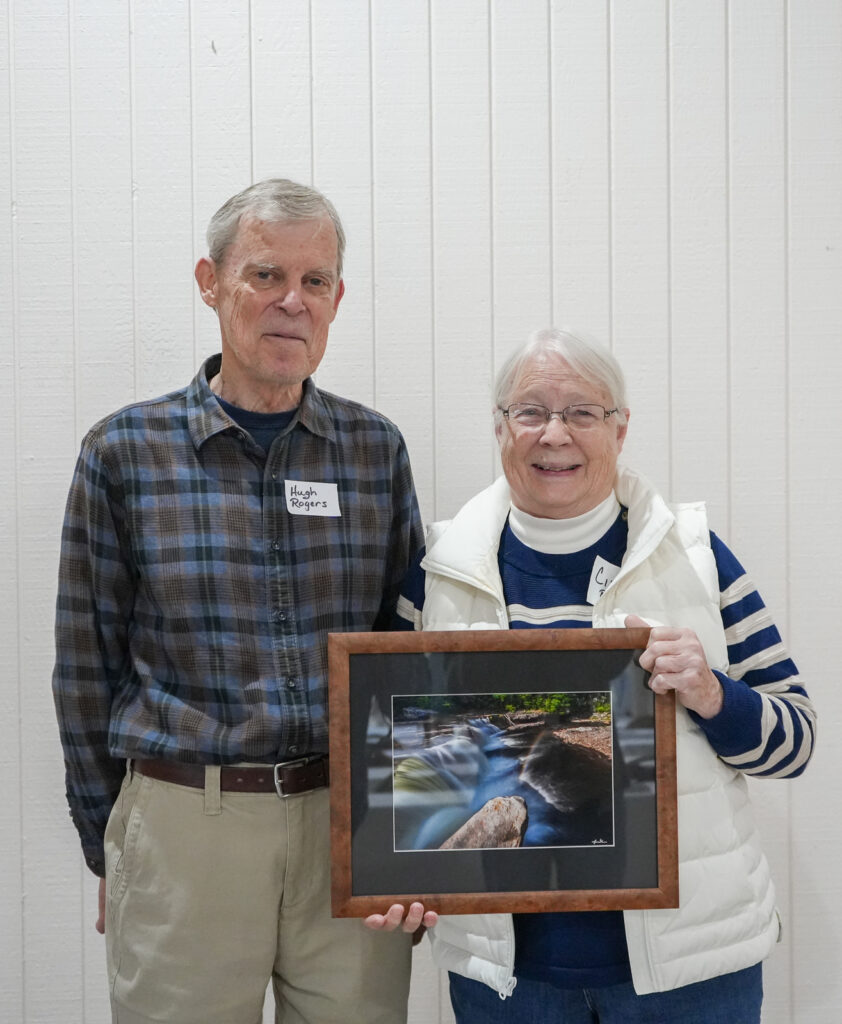There is no greater connector—or reminder that we humans are inextricably linked to nature—than water. Clean water gives us life, good health, and nourishment. Although it is treated as one, it is so much more than merely a resource.
On the weekend of Oct. 13, members and supporters of the West Virginia Highlands Conservancy gathered at Canaan Valley Resort State Park to learn about threats to our water and how we can, and are, working to care for it. The fall foliage blanketing over West Virginia’s mountaintops was the most striking in recent memory. It provided an inspiring backdrop for the many great speakers who presented at the Fall Review.
On Saturday morning, we were delighted to have Pam Edwards, former Forest Service research hydrologist, and Rick Webb, executive director of the Allegheny-Blue Ridge Alliance, discuss an issue of growing concern that severely affects the health of our streams: sedimentation. Sediment pollution is caused by soil erosion. Erosion is a natural process caused by water or wind but is being accelerated by humans through deforestation, construction and urban development, mining, agricultural practices, invasive species, climate change, and so on.
Pam’s presentation focused on Best Management Practices, known as BMPs, that are used to prevent or control the amount of sediment entering a waterbody by human activities. Pam noted that while they are called best management practices, they are not, after all, the best we could be doing at controlling sedimentation.
More importantly, waters are measured for good health by water quality standards set for human toxicity levels, neglecting to account for the toxin levels of aquatic organisms, who are much more sensitive to changes in water quality—causing negative impacts on reproductive ability and food availability.
Some species can withstand a higher level of pollutants than others or are able to move to find cleaner waters. Rick’s presentation shifted our attention to the endangered candy darter, an example of a species that is unable to escape pollution like the native brook trout can. Half of the candy darter’s historical range has already been lost, and a major driver of this loss is sedimentation and stream degradation.
There are many ongoing and planned projects within the candy darter’s critical habitat, like the Mountain Valley Pipeline and the Forest Service’s proposed 1,700 acres of clear-cutting in the Greenbrier Southeast project, that further threaten the candy darter by polluting streams with sedimentation. Rick explained that within the Monongahela National Forest, sedimentation is a chronic problem, and we do not know exactly where it is coming from. A recent complaint brought by the West Virginia Highlands Conservancy against the Forest Service urges that the source of the problem be identified and addressed.
Madison Ball, conservation program director of Friends of the Cheat, discussed a more familiar water pollutant: acid mine drainage. In 1995, the Cheat River was named one of the country’s most endangered rivers; thanks to the work of Friends of the Cheat and its partners, it is once again alive with life. To date, Friends of the Cheat has built 20 acid mine drainage treatment systems, with two more in the planning stages.
Madison gave us a harrowing reminder that while the rebirth of the Cheat River is incredible progress, the source of acid mine drainage can never be fully remedied. Acid mine drainage from underground mining operations will continue to seep out of the Earth well past our lifetimes, continuously polluting for thousands of years until the pyritic material in the mine has deteriorated.
After a delicious lunch spread and the chance to rest our minds, we reconvened for a brief outing to tour the state park’s water treatment plant. One tiny building below the lodge is responsible for the processing of nearly 18 million gallons of water that is supplied to the park’s various buildings, including the ski resort, in a single year.
Following the outing was a panel focused on small-town water issues and PFAS (per- and polyfluorinated substances) with Luanne McGovern, the Conservancy’s senior vice president, Mike Hawranick from the West Virginia Division of Health and Human Resources, and Cory Weese from the West Virginia Rural Water Association.
As with acid mine drainage, there is no clear end in sight for the proliferation of PFAS in the environment and within our bodies. What was also made clear is that no one has a straight or reassuring answer for how to deal with this overwhelming problem.
The manufactured group of PFAS chemicals are known as “forever chemicals” because they can take more than a thousand years to degrade. PFAS poses a severe threat to human and animal health and have been detected in the bloodstream of 99% of people living in the United States.
In July 2022, the state released a study of PFAS in West Virginia’s pre-treated source water. In the study, PFAS was detected in 130 community water systems around the state. Mike regrettably noted that we are just at the beginning of this wild PFAS journey.
After being scared straight by PFAS, we took a moment to switch gears and honor someone who has selflessly and tirelessly worked to protect our water. Upon her retirement from the Conservancy’s Board of Directors, Hugh Rogers presented Cindy Rank with the Water Warrior Award in appreciation of her 44 years of dedicated volunteer service.
Hugh expressed that Cindy changed the nature of the Conservancy from an organization whose mission was solely focused on the Highlands to a broader vision of protecting the state and its people in its entirety.
As a testament to her wisdom and courage, Hugh quoted Cindy’s testimony before a senate committee,
“Water is at the heart of it all. Having nowhere to put the deep layers of Earth that separate coal seams, companies blast apart and dump the rock into the stream valleys that originate in the high reaches of the mountain and flow down the hollows between the ridges. Pockets of groundwater, perched aquifers, and hillside springs that many of us depend on are gone in an instant. One of the main goals of the Surface Mining and Reclamation Act was to uphold the Clean Water Act. Water is at the heart of it all.”
In perfect order, we heard from another West Virginia water warrior next. Angie Rosser is the executive director of the West Virginia Rivers Coalition. She delivered an uplifting and inspiring presentation on the power of collective action and brought attention to some of the issues we will likely be presented with in the upcoming legislative session that could impact our water.
Angie reminded us that the environmental movement is a game of incremental progress, and we have indeed made incremental progress in recent years. Among these successes are the pushback against off-road vehicles on public lands, the PFAS Protection Act, the defense of the Aboveground Storage Tank Act, and an increase in the number of inspectors of orphaned gas wells.
The keynote address was given by Nicolas Zegre, associate professor of forest hydrology at West Virginia University, who approached the subject of water from a different perspective than we had heard throughout the day’s earlier sessions. His address, “Preparing Agents of Change for Tomorrow: Climate Justice and Action in the Mountain State,” focused on flooding.
In short, flooding is getting worse in West Virginia. From 2006 to 2022, there were 1,683 flood events in the state. Since 2016, there have been 968 recorded flood events. It is estimated that 46% of our roads are at risk of flooding. West Virginia faces the highest flood risk in the country. As the Earth’s temperature increases, extreme rainfall will continue to increase and lead to even more flooding.
In recognizing this problem, Nico and a team of researchers at WVU’s Center for Resilient Communities are working to build youth-led climate resiliency in communities most impacted by increased flooding. Preparing Agents of Change for Tomorrow (PACT) is a program that works with youth to create flood resilience plans in their communities and identify the unique drivers causing flooding in their area. The PACT curriculum being developed for the program will be publicly bundled and distributed across the state.
Nico left us with a reminder that we all live in watersheds, and we all must be involved with our local watershed organizations. A good place to start demanding action is to advocate for funding of the West Virginia Flood Resilience Law (SB 677). Despite its passage in March 2023, the bill has yet to be funded.
Following the keynote address, those who weren’t too tuckered out from the busy day square danced the night away with caller Bob Smakula. We were accompanied by live music from Kevin Chasser, Andy FitzGibbon, and Nate Druckenmiller.
Thank you to all the volunteers who made the Fall Review such an enjoyable experience, the speakers for sharing their knowledge, the staff at Canaan Valley Resort State Park for being so accommodating of us, and, of course, to the attendees who joined us for the fun. We hope to see you at next year’s Fall Review, Oct. 11-13, 2023, at Cacapon Resort State Park.


